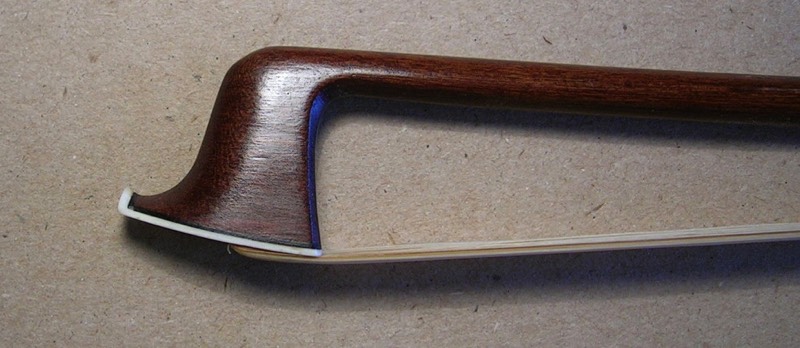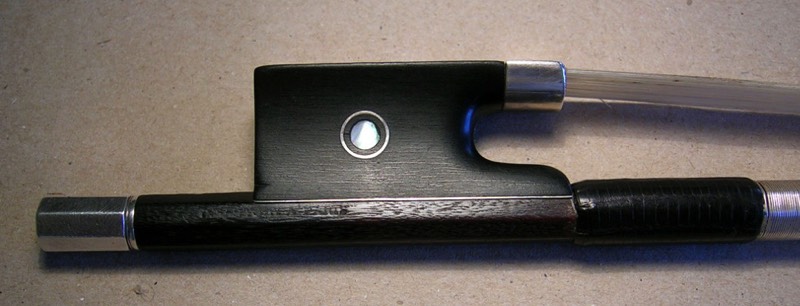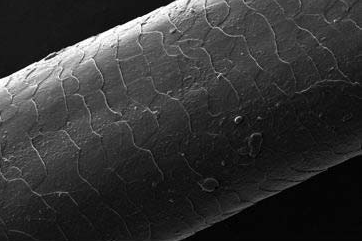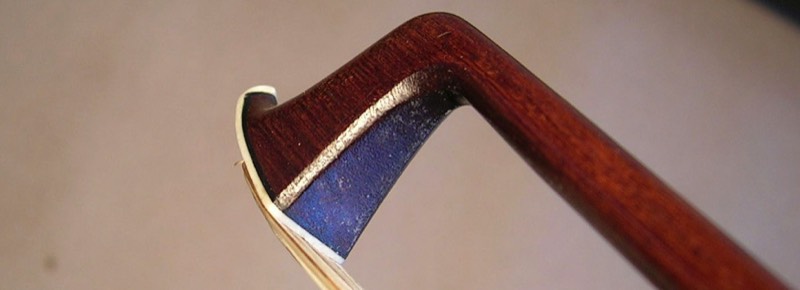
The violin wouldn't be much without a bow, and yet until last century it was considered almost an accessory along with the case and tuning fork. Having said that, there have always been bows of exceptional craftsmanship and beauty admired by those with eyes to see.
The development of the violin bow to it's modern form was perfected by François Tourte (1774-1835). Trained as a watchmaker, he took to bow making as did his father and brother. After a painstaking search he came to the conclusion that pernambuco was the ultimate material for bows given it's weight, strength and elasticity. Pernambuco was used in early times as a colorant for dyeing fine chlothes and was then called Brazil. It grows in South America and the country we know as Brazil actually got it's name from the wood and Pernambuco is in fact a region in Brazil.
Until 1775 the bow's length and weight hadn't been established as standard. Working on the advice of famous viruosi such as Viotti, Kreuzer and Rode, Tourte introduced many features still used today and established the optimal length of the violin bow at 74 0r 75 cm. in all, the viola bow at 74 cm. and the cello bow at 72-73 cm.
Bows are generally made by specialist bow makers although some violin makers have made bows as well. One of the tasks which a violin maker is trained in however is the re-hairing of bows. Rehairing a bow is a time consuming and troublesome job. The main reason for this is that to rehair a bow properly without damage requires lot's of patience and skill. Too many good bows have been badly damaged by people who have learned bow rehairing from a book and think that it might be a lucrative way to watch television. Bows should be entrusted only to trained professionals. Among the worst of the damage we come across are:
The development of the violin bow to it's modern form was perfected by François Tourte (1774-1835). Trained as a watchmaker, he took to bow making as did his father and brother. After a painstaking search he came to the conclusion that pernambuco was the ultimate material for bows given it's weight, strength and elasticity. Pernambuco was used in early times as a colorant for dyeing fine chlothes and was then called Brazil. It grows in South America and the country we know as Brazil actually got it's name from the wood and Pernambuco is in fact a region in Brazil.
Until 1775 the bow's length and weight hadn't been established as standard. Working on the advice of famous viruosi such as Viotti, Kreuzer and Rode, Tourte introduced many features still used today and established the optimal length of the violin bow at 74 0r 75 cm. in all, the viola bow at 74 cm. and the cello bow at 72-73 cm.
Bows are generally made by specialist bow makers although some violin makers have made bows as well. One of the tasks which a violin maker is trained in however is the re-hairing of bows. Rehairing a bow is a time consuming and troublesome job. The main reason for this is that to rehair a bow properly without damage requires lot's of patience and skill. Too many good bows have been badly damaged by people who have learned bow rehairing from a book and think that it might be a lucrative way to watch television. Bows should be entrusted only to trained professionals. Among the worst of the damage we come across are:
- Split heads and frogs from forced wedges.
- Scratched and indented metal fittings and pearl.
- Distorted stick shapes due to uneven tension.

A bow which is being used regularly generally has to be fitted with new hair at least twice a year. Over-used hair has lost it's capacity to hold the rosin properly and the player will notice the bow's lack of efficiency to produce a good tone.
It is often heard that horsehair for bows must be quite white and exceptionally smooth. While it is true that irregularities in the hair's structure can cause noise, hair is a natural material and is seldom perfect. Completely white hair is very rare unless it has been bleached. The hair's whiteness is not neccessarily it's most desirable attribute. Often the finest hair is anything from light-beige to butter coloured. Bleached hair is generally brittle and should be avoided as it doesn't last very well. Fine bowhair is exported from Canada, South America, Australia, China, Japan, Hungary and Russia.
It is often heard that horsehair for bows must be quite white and exceptionally smooth. While it is true that irregularities in the hair's structure can cause noise, hair is a natural material and is seldom perfect. Completely white hair is very rare unless it has been bleached. The hair's whiteness is not neccessarily it's most desirable attribute. Often the finest hair is anything from light-beige to butter coloured. Bleached hair is generally brittle and should be avoided as it doesn't last very well. Fine bowhair is exported from Canada, South America, Australia, China, Japan, Hungary and Russia.

The thickness of horsehair is around 0.04mm and it is entirely made up of dead cells which have been converted into a protein called keratin. Keratin is the favorite food of Anthrenus Museorum or the museum beetle, the larvae of which feed on all kinds of animal hair. If you should come across such a creature, don't panic. It is a very slow animal and can easily be brushed or hoovered from a violin case. Cut out the old hairs and burn them as well as treating the case with a common insecticide that kills larvae. These larvae detest sunlight by the way so an old violin case with half eaten bow is well kept in open sunlight for a while. The surface of the hair is covered with scales overlapping away from the "horse end" of the hair.
The most important characteristics of a good bow for the player are:
Rosin is what makes the bow stick to the string until it slips back in a continual cycle which generates the bowed sound. It is made of colophony-the residue from the distillation of turpentine. It comes in various grades depending on the type of distillation. Pure colophony is far too brittle to use on it's own for violin rosin and makes an unpleasant scratchy sound. Therefore it is generally mixed with other substances to modify it's consistency. Most rosin will contain small amounts of oil to plasticize or soften it and sometimes there are additions of alkaline solutions to neutralize the colophony which is quite acid. The acidity of colophony can be a hazard to the varnish if it is allowed to build up on the instrument.
The most important characteristics of a good bow for the player are:
- Ability to sustain tension on the hairs without having to tighten the screw too much.
- Ability to maintain this tension and being flexible without the need for unneccessary weight.
- A nice well shaped cambre right to the tip of the bow, which results in the stick touching 2/3 of the length of the bow from the frog, when the frog and head are resting on a flat surface and the bow is under no tension.
Rosin is what makes the bow stick to the string until it slips back in a continual cycle which generates the bowed sound. It is made of colophony-the residue from the distillation of turpentine. It comes in various grades depending on the type of distillation. Pure colophony is far too brittle to use on it's own for violin rosin and makes an unpleasant scratchy sound. Therefore it is generally mixed with other substances to modify it's consistency. Most rosin will contain small amounts of oil to plasticize or soften it and sometimes there are additions of alkaline solutions to neutralize the colophony which is quite acid. The acidity of colophony can be a hazard to the varnish if it is allowed to build up on the instrument.


